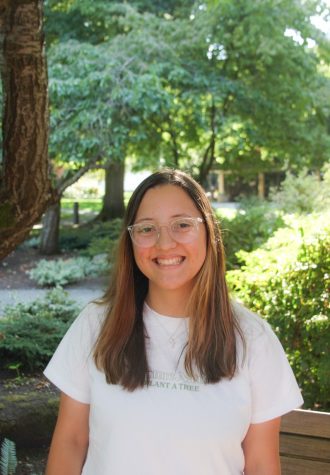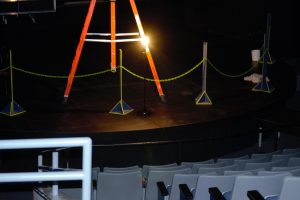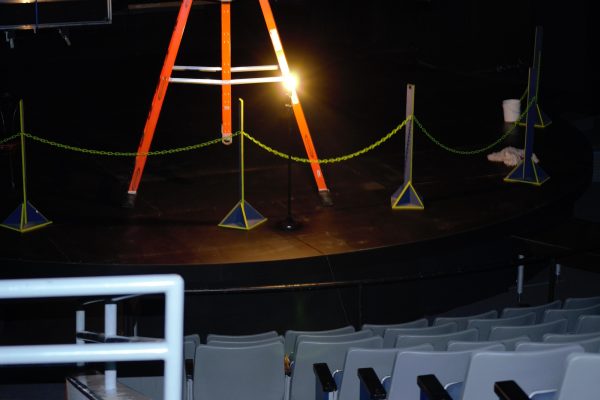Fulfillment of professor’s dream
Whale skeleton in Eaton Hall makes Dr. Moe’s dream come true
September 9, 2020
College has always been a place where lifelong dreams can finally come to life. For Assistant Professor of English and Director of Campus Writing Dr. Peter Moe that still remains true.
Moe has chosen English as his career, but he has not let it take him away from other passions.

“I’ve always been interested in whales,” Moe said. “We don’t know that much about them…we don’t even know how many species of whales there are. We put a man on the moon in 1969 and didn’t get underwater footage of whales swimming until 1984. I just think that’s amazing.”
Taking this fascination of whales and transforming it into a class to build a whale skeleton has led to Eaton Hall receiving a new feature. Dr. Moe has been able to turn his passion into a dream and his dream into reality.
The love of whales has lasted a lifetime for Moe, but the dream of building a whale began back in 2017. Moe explained that as he was standing in Eaton Hall one day he stared at the empty space located directly next to the main entrance. He heard of a whale that had recently been washed up and inspiration immediately struck.
After Moe proposed the idea of hanging a whale skeleton in front of Eaton Hall to the Dean, the Dean was fully on board.
“When we built this building a lot of faculty were angry about it because of all the empty space in front. They thought it was wasted. But the architect in charge of the building said that eventually we could hang a whale skeleton there,” Moe said, quoting the Dean.

The space would finally be fulfilling its potential.
“This whole space was literally designed for a whale,” Moe said.
By the time Moe had heard of and traveled to retrieve the whale in 2017, the body had been engulfed by the shores. Without the budget or equipment to pull it out, this whale was no longer an option.
After realizing that whale was not attainable, Moe decided to wait for the next one alongside his partner on the project, Rus Higley. Higley is a professor at Highline College who has previously built three other whales.
Finally, a couple years later, another whale washed up and Moe jumped on the opportunity.
“[The whale we’re using] washed up in 2019 out on the southern end of the Kitsap Peninsula,” Moe said.
In a 30 foot space, this 29 foot whale was a perfect fit. After transporting the whale to a farm, 25 students participated in cutting out the bones and preparing them to be cleaned. Moe described how he felt a sense of mortality during this process.
“Originally when we pulled the whale up, it weighed 16,000 lbs. The bones we pulled out, cleaned, and used to assemble this whale only weigh 518.3 lbs. There’s this sense of mortality that I am reminded of. ‘From dust you came to dust you shall return’…I know I’ll be reduced to bones in like 50 years.”
In about 10 months, the extraction of oil from the bones and cleaning process came to an end and the building process was about to begin.
Moe’s whale building class consisted of 20 students broken up into two crews, the morning and afternoon crew, in order to allow for proper social distancing. During summer, this three week class took place each week day 9am-4pm.
Scattered throughout Eaton Hall, the students split up into assembly crews that consisted of tasks such as drilling holes, mixing and pouring specialty glue, and organizing the layout of the whale.
These tasks looked different than they would have in a non-COVID world due to social distancing and group guidelines. Having to rotate responsibilities one by one rather than in one cohesive time frame made the assembly difficult, but not impossible.
After weeks of building, Moe’s dream came to life.
“I’ve been dreaming about this for three years and I’m thrilled it is finally here,” Moe said.
The assembly of this whale is even more than just a dream come to life. For Moe, it is a sacred moment.
“Everytime I pick up one of these bones it feels a little emotional. This whale was born in Baja, got up to Alaska, and went back down to Baja a couple times. I’m holding this bone that was in its body; it went on this journey and it feels sacred, almost holy, to hold it in my hands,” Moe said.

Quoting poet Kathleen Jamie, Moe reflected on why this whale has made a lasting impact on his life already.
“I think about my wife and I think about my son. I know them really really well. But that’s it.” Moe said. “Like Kathleen Jamie says, ‘unless you have a professional interest its possible the only bodies you have been intimate with, have scrutinized, have been the bodies of lovers or of children.’”
Moe’s passion for the project began to truly reveal itself through the tears that began to form as his emotions caught up to him while talking about the whale.
“So now the whale is in that same category as my wife and son, which is really intense,” Moe said. “And I think that’s why it’s an emotional thing…I’ve never been this close to a body except for these really cherished relationships. It’s weird to have a whale be a part of those cherished relationships.”
As the whale resides in Eaton Hall from here on out, it will become a window into the unknown. Students will get to see a sneak peak into the mystery of whales. They will see how a man’s passion transformed into something tangible. They will get the opportunity to feel closer to nature, closer to the Creator even.
“My hope is that when people stand under this whale it’ll prompt the really hard questions in life: ‘What’s our relationship to animals?’ ‘What’s our relationship to nature?’ ‘Can you ever really know nature?’ “What do we really know about God?’” Moe said.
Check out the assembled whale skeleton at the front of Eaton Hall and be on the lookout for Dr. Moe’s book on whales coming out in 2021, Touching This Leviathan.

























































































